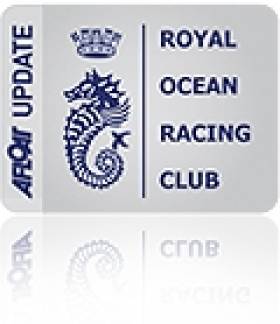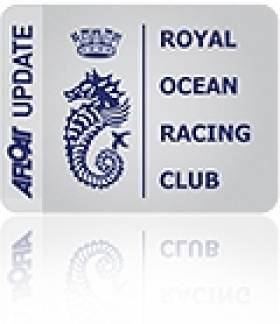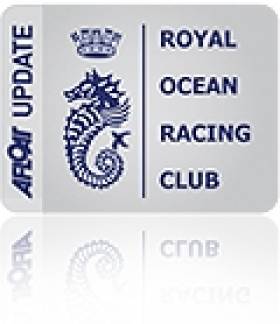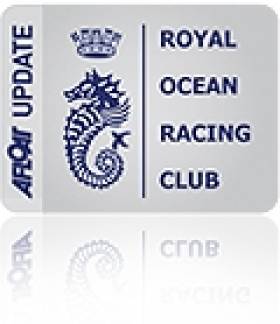Displaying items by tag: RORC
#rorc – The RORC Rating Office, the technical and administrative hub for all things Spinlock IRC rating-related in the UK, is re-badging its Limited Validity TCC (LV TCC) as the Single Event Rating (SER) with immediate effect.
The LV TCC scheme was an initiative launched two years ago as a means of introducing new owners to the benefits of racing under IRC without them having to apply for a full certificate. If owners only wanted to race in one or two events in the year they could apply for an LV TCC, with an upgrade to a full IRC certificate offered at a reduced rate.
The change of name is primarily being introduced to provide a more understandable and user-friendly path to build on the success of the past two years. 2014 saw 81 events accepting LV TCCs with 117 certificates being issued, compared with 54 events and 124 LV TCCs being issued in 2013.
A gateway into IRC racing
The newly branded SER is being rolled out to regatta and race organisers across the UK, with encouragement to include it in communications with their members and potential race and regatta entrants.
In spite of the LV TCC option already being widely available at club events and having been taken up by most major events over the past two years, the vast majority of interest has been from those run in the Solent region e.g. Aberdeen Asset Management Cowes Week, the J.P. Morgan Asset Management Round the Island Race and Panerai British Classic Week.
The LV TCC has given owners the opportunity for a memorable day or week of IRC racing at minimal cost. However, it is positive to note that a small number of boats that held LV TCCs in 2013 have upgraded to full IRC certificates in 2014 and as the Rating Office Technical Director, Mike Urwin, comments, "We may not yet be seeing vast numbers but it is satisfying to have made some converts."
He continues, "Noting the apparent strong Solent/major event bias, while the significant increase this year in the number of events accepting LV TCCs confirms that Clubs around the UK are keen to get more people racing, we recognise that many potential racing owners are not aware of the SER option, or the help and advice they can get from their local IRC Advocates or the Rating Office.
"We hope that the change of name will make SER more accessible and widely recognised, and. we will also be talking further to club officials and members at the regional level including seminars to be jointly held with the RYA this winter."
#rorc – Members of the Royal Ocean Racing Club (RORC) and the Royal Corinthian Yacht Club, Cowes (RCYC) have confirmed that the two clubs will merge to form one club. At Extraordinary General Meetings of RCYC (held on 24 August) and RORC (held on 28 August) an overwhelming majority of members voted in favour of the merger, in the case of RORC 93% and in the case of RCYC (Cowes) 87% of members that voted.
"This is an important milestone in the history and development of the RORC, which celebrates its 90th year in 2015" explained RORC Commodore Mike Greville. "The proposal to combine the two clubs evolved from a shared vision about what they could create together, which neither could achieve alone. For RORC this gives a permanent base and clubhouse facility at the very heart of UK yachting and for RCYC this creates a strong club at the forefront of international yachting, which can support its development as a preeminent Solent club. We are very encouraged by the huge level of support which this proposal has generated from members of both clubs. "
RCYC Vice Commodore, Amanda Dreyer was equally positive about the decision. "During our initial discussions with RORC earlier this year, we identified that both RCYC and RORC have similar cultures and long-term strategies for growth. With RCYC's objective to be a vibrant club offering improved facilities, and RORC's vision for a base in Cowes, there are powerful and mutual benefits for both great clubs. I am delighted the merger has the approval of our Members and in the confidence this gives to Cowes, to be at the heart of yachting."
The combined Club will operate under the name of RORC although the Royal Corinthian name will be preserved for use in connection with the Cowes clubhouse and Solent based inshore racing. The headquarters of the Club will remain at the London clubhouse in St James's .
The effective date of the merger is to expected to be 10 November 2014 as anticipated at the end of this blog on Afloat.ie by W M Nixon on August 2nd.
International Fleet Bound for Malta 2014 Rolex Middle Sea Race
#rorcrmsr – The 606-mile yacht race takes place in the heart of the Mediterranean and covers one of the most beautiful courses in the world. Starting and finishing in Malta, the route includes the deep azure waters around Sicily including the Aeolian and Egadi Islands, as well as Pantelleria and Lampedusa. One of the most stunning vistas is Stromboli, the active volcano which is a course mark. Last year, a record 99 yachts took part and with less than two month to the start of the 35th edition, 69 yachts have already entered from 17 different nations.
"The entry level so far is very encouraging, we expect to have about the same number as last year but the club would love to see the entry list past the 100 mark for the first time, since the first edition of the race in 1968." commented Godwin Zammit, Commodore of the Royal Malta Yacht Club. "The quality of the entrants seems to be going up every year, amongst them we have sailors from all over the world; world champions, top professionals, as well as corinthian sailors. The Rolex Middle Sea Race is the highlight of the year for the Royal Malta Yacht Club and all of the competitors will be made very welcome at our clubhouse during the event."
The Line Honours favourite for the Rolex Middle Sea Race is Igor Simcic's Maxi, Esimit Europa 2, skippered by by multiple Olympic and America's Cup winner, Jochen Schümann. The 100ft canting keel maxi has taken line honour victories in the years from 2010 – 2012, becoming only the second yacht in the history of the Rolex Middle Sea Race to take it three times in a row. Last year, Esimit Europa 2 damaged their mast on the way to the race and was unable to compete but the Slovenian yacht, with a world class international crew is returning with the goal of taking Line Honours for an unprecedented fourth occasion.
The battle for the overall win after time correction is already developing into a fascinating competition. Niklas Zennström's Team Rán have won numerous blue ribbon offshore events and world championships but an overall win in the Rolex Middle Sea Race, has eluded them on three separate occasions. Niklas Zennström's latest Mini Maxi, Rán 5 will be competing in October and their immediate rivals on the water will include Roberto Tomasini Grinover's Mini Maxi Robertissima. Several other world class Mini Maxis are also expected to be competing.
A Cookson 50 has won the Rolex Sydney Hobart, Rolex Fastnet Race and the RORC Caribbean 600 but the canting keel flier has yet to win the Rolex Middle Sea Race overall. This year, three Italian Cookson 50s will attempt to change that statistic. Guido Paolo Gamucci's Clippa Lippa and Germana Tognella's Cantankerous have raced before but Vincenzo Onorato's Mascalzone Latino will be making their first appearance with Volvo Ocean Race winner, Jules Salter on board as navigator.
Three of the fastest yachts in this race should have a fascinating battle on the water. This August, Jens Kellinghusen's German Ker 51, Varuna was the overall winner of 2014 Sevenstar Round Britain and Ireland Race and class winner for the 2013 Rolex Sydney Hobart. Varuna is being shipped to Malta especially for the Rolex Middle Sea Race, Round the world yachtsman, Guilermo Atadil will be navigating the German entry. Jascha Bach and Toni Guiu, Spanish TP 52 Balleria is en route from Barcelona, hoping to emulate last year's overall winner, TP52, B2. German Carkeek 47, Black Pearl will be making its debut at the Rolex Middle Sea Race. Skippered by Stefan Jentzsch, the all carbon flyer will have a stella crew including, Marc Lagesse, James Carroll, Peter van Niekerk and Luke Molloy.
Royal Malta Yacht Club member, Finis Pit will be racing his German Ker 53, Dralion with just two crew, already six yachts will be racing in the IRC Double Handed class including race veteran, Beppe Bisotto who will be racing his Venetian Fast 42, Atame.
Six majestic Swans will also be taking part this year, including Grey Goose of RORC sailed by Tobias Koenig. Swan 65. Eddie Craighill's Swan 65, Rebel Jaguar, will be skippered by Franck Petitgas. Dmitriy Samohin, President of the Russian Dragon Class will be racing Swan 60, Petite Flamme with Olympic and America's Cup helmsman, Andy Beadsworth as part of the crew. Monaco's Paul Basson will be racing his elegant Swan 46, Foreign Affair Two Handed. James McGarry's Scottish Swan 45, Eala of Rhu will be sailing to Malta having competed in the Swan 45 World Championship in Sardinia. Chris Frost's elegant Swan 36, Finola was launched in 1968, the fourth Swan ever built is still very competitive, having won class at the 2013 Swan European Championship, winning every race.
The Rolex Middle Sea Race attracts a variety of yachts including timeless classics such as the classic yawls, Tomahawk and Stormy Weather. Tomahawk was designed by Sparkman & Stephens as an ocean racer in 1938 and was sympathetically rebuilt to her original design by the present owner, Jamie Abdy Collins. Stormy Weather of Cowes was designed by Olin Stephens in 1934. In 1935 she won both the Newport-Bergen Transatlantic race and the Fastnet race. Stormy Weather has been owned by Christopher Spray, from the UK, for the past nine years. Tarquin Place, from Tasmania is the boat captain.
Entry for the Rolex Middle Sea Race closes on October 3rd 2014.
Round Britain & Ireland Fleet Blast Off On Epic Circumnavigation
#rorcsrbi – The five VO65s and MOD 70 Musandam-Oman Sail along with the rest of the fleet in the Sevenstar Round Britain and Ireland Race power reached through the line and are now officially away for an 1800–mile blast around Britain and Ireland. Yesterday's start was posponed due to strong winds. AZZAM got the best start but Team SCA just blasted their way through to windward and were steaming ahead only minutes after the gun. Musandam-Oman Sail was only on one hull in a ball of spray, doing 30 knots!
All 28 yachts are now heading east along the Solent having now started the 1800 mile race around Britain and Ireland. A large crowd of spectators outside the Royal Yacht Squadron saw the fleet away. In bright sunshine, with a stiff southwesterly wind and a significant positive tide, it was a magnificent start with yachts flying through the surf under spinnakers.
At 1130 BST, all of the fleet are now past Selsey Bill, experiencing over 30 knots of breeze as they reach at top speed along the south coast of England. Musandam-Oman Sail, skippered by Sidney Gavignet, has averaged 30 knots of boat speed since the start. If the MOD70 keeps that up the team will finish the course in two and a half days, smashing the course record.
"We could be very close to the record but I am not sure at this stage that we will break it," commented Sidney Gavignet. "The computer says we can, but the reality is that the sea state will probably slow us down a bit - and we will still have 40 knots overnight, so for this we don't want to rush as the quicker we go the more wind we will have."
The IRC and Class40 Fleet start saw Brian Thompson's IMOCA 60, Artemis - Team Endeavour, judge the line to perfection, blasting through the short chop at full power right on the gun. However, Andrew Budgen and Fred Schwyn's Volvo 70, Monster Project showed terrific downwind speed to take up the lead. The two canting keel downwind flyers are now locked in a high speed duel averaging 20 knots of boat speed and that battle is likely to continue for the next four or five days. Just two hours into the race, Artemis - Team Endeavour are leading overall after time correction from Monster Project.
Concise 8, skippered by Ned Collier Wakefield, leads the Class40s, opening up a two mile gap on Burkhard Keese's German Class40, Stella Nova.
The five Volvo 65s screamed through the start line flying Code Zeros, all bar Abu Dhabi Ocean Racing's Azzam, skippered by Ian Walker, which started with a smaller A3. Team SCA, skippered by Sam Davies, got the best start but Azzam soon peeled to the Code Zero to fly into the lead. However, Team Dongfeng, skippered by Frenchman Charles Caudrelier, was just in the lead at 1100 BST. Three teams have taken the lead in the Volvo 65 class in the first two hours, a pattern that may well continue right through the race.
IRC Zero
At this very early stage, Jens Kellinghusen's Ker 51, Varuna, is the class leader and third overall. In the last 12 months, Varuna has competed in the Rolex Sydney Hobart, RORC Caribbean 600 and the Transpac. Spanish navigator Guillermo Altadill and Australian Luke Molloy are on board to strengthen the highly experienced German crew. Varuna is fully lit up, averaging over 15 knots and surfing significantly faster in the downwind conditions.
IRC One
Jankees Lampe's Open 40, La Promesse, is revelling in the downwind conditions. The other half of the Dutch Two-Handed team is Bart Boosman, who was shouting for joy at the Skippers' Briefing when he heard that the course was being reversed. La Promesse is trucking along, averaging over 15 knots, leading IRC One and the Two-Handed Class and fourth in IRC Overall.
IRC Two
The fleet of five yachts are virtually neck and neck, with Ross Applebey's Oyster 48, Scarlet Logic, leading the fleet by virtue of having the lowest rating in the class. However, the downwind start will be highly desirable for The Army Sailing Association's J/111, British Soldier, as well as Chris Radford's J/122, Relentless on Jellyfish.
Conrad Manning, racing Two-Handed on Ian Hoddle's Figaro II, Rare, sent this message from the race track. "What a sight! The VO65 fleet just came screaming past us and we can see Oman Sail flying on one hull at an incredible speed. We are really flying as well, it's blowing 30 knots out here and the speedo hasn't dropped below ten knots since we started!"
IRC Three and IRC Four
The only boat in IRC Four, Lula Belle, leads the two faster IRC Three boats, Change of Course and Ruag White Knight 7 on the water, a fantastic start for the Two-Handed team from Ireland. The three boats are fairly closely rated and will be looking forward to their own battle around the course which is likely to last almost two weeks.
Royal Cork Yacht Club Welcomes Home the Commodores' Cup
#rorcbdcc – It was a night of pride, joy and no little emotion at Royal Cork Yacht Club as winning Commodores' Cup captain Anthony O'Leary brought the Cup home to Crosshaven writes Claire Bateman.
Last night was the occasion for Anthony O'Leary to return, for the second time to his home base, the magnificent Commodores' Cup first won in 2010.
Admiral Pat Lyons, members of the Executive Committee, members and staff were on hand to join in with the enthusiastic welcome accorded to the Irish team members present and the Admiral accepted the presentation of the Commodores' Cup to display where all can admire this beautiful trophy.
Also joining in the celebrations were Norbert Reilly, Commodore, Irish Cruiser Racing Association and David Lovegrove, ISA President.
The gathering enjoyed a drinks and finger food reception before going on to the official part of the evening.
Admiral Lyons in his welcome and congratulatory speech welcomed everyone and was proud to illustrate how sailing develops from the youngest members in their Optimist dinghies right through the ranks to the ultimate accolades at the highest end of sailing.
He also pointed out that of the thirty one members of the Irish winning team at Cowes no less than fourteen of them were from the Royal Cork Yacht Club and said he would like to emphasize it was not just the winning of the event but the manner in whicb it was accomplished with a tremendous margin of almost 175 points.
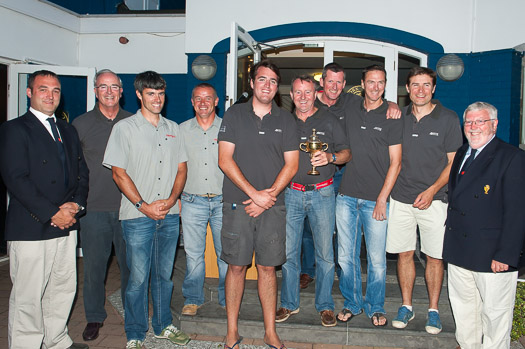
Happy crew – members of the Commodores' Cup team are welcomed home by Admiral Pat Lyons (right) and RCYC flag officers. From left to right are: Kieran O'Connell Rear Admiral Keelboats, Anthony O'Leary, Peter O'Leary, Alan Curran, Robert O'Leary, Dan O'Donovan,Tom Durcan, Clive O'Shea, Derek Moynan Photo: Bob Bateman
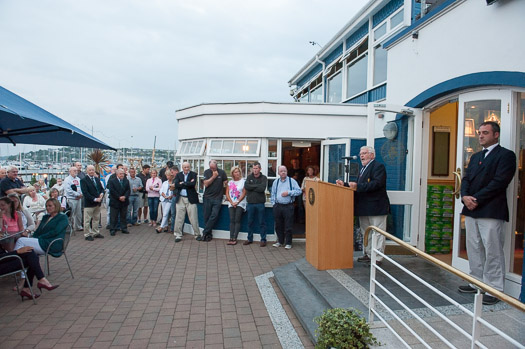
Royal Cork turns out to welcome home the cup. Photo: Bob Bateman
In his reply Team Captain Anthony O'Leary endorsed the Admiral's comments regarding junior sailing and none better to do this as he has been involved in the promotion of the juniors since the early nineties and especially in the promotion of Optimist sailing. He then went on to give due credit to the other team skippers of the Irish Team, Marc Glimcher from the United States. He mentioned that Marc had added Patrick to his name during the week to assert his Irishness.
He then went on to explain the difficulties experienced by the co-charterers of Quokka 8, Michael Boyd and Niall Dowling, in trying to overcome delays in having the boat returned from the Carribeann and the magnificent effort they put into chartering other boats to work up with the squad while awaiting Quokka's return and one can only marvel at the results obtained.

Team Captain Anthony O'Leary (left) hands the Cup over to Admiral Lyons. Photo: Bob Bateman
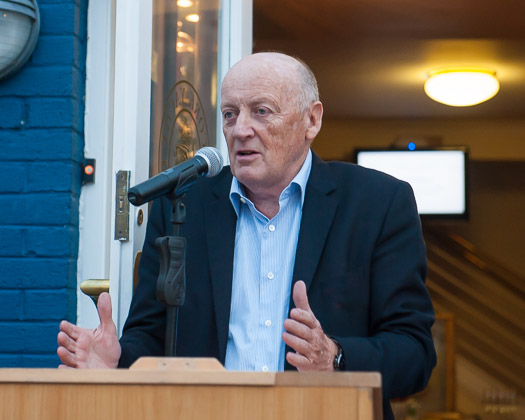
ICRA Commodore Norbert Reilly
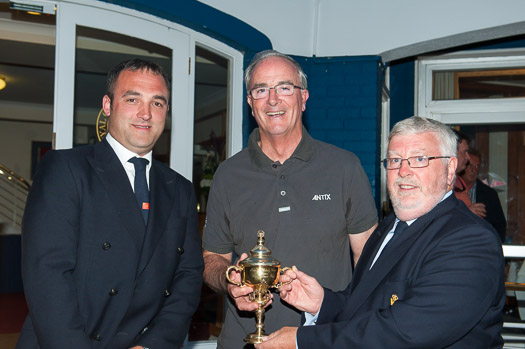
ICRA Commodore Norbert Reillly spoke and told of the astonishment of the other teams at how the event was won. Where the other countries had boats for heavy weather, light weather and where we had a Ker 40 they had two Ker 40s. Where Ireland had a Grand Soleil, they had a Grand Soleil and where we had a Ker 39 they had a Ker 39 and he jokingly mentioned that he was sure Ker 39's would now treble in value throughout the yachting world which resulted in a round of applause and cheers. Commodore Reilly didn't miss a trick and also pointed out that the Irish had "cleaned out all the other trophies at the Commodores' Cup event".
Following the finish of the official welcome home, the prize giving took place for the final night of the Marshall Marine League.
TOMORROW ON AFLOAT.IE
THE COMMODORE¹S CUP – HOW IRELAND WON IT, AND WHERE IT MIGHT GO FROM HERE
Tomorrow in Afloat.ie's Sailing on Saturday blog W M Nixon meets winning Team Captain Anthony O'Leary for a free-ranging discussion about Ireland¹s convincing international victory in the Brewin Dolphin Commodore¹s Cup, how it was done and what the future could bring. Click HERE.
Ireland Extend Commodores' Cup Lead in Cowes
#rorcbdcc – Ireland's three boat Commodore's Cup team has taken a commanding lead on the Solent, leaving four British and four French teams in its wake. This afternoon, the Irish Cruiser Racing Association (ICRA) team extended it's lead to 99.5 points clear of GBR Red after three windward-leeward races.
Three windward-leeward courses were sailed in testing conditions and heat that reached 30 degrees celsius on The Solent. The breeze rarely exceeded 8 knots and an ebb tide of up to 2.5 knots crossed the course area.
Both Marc Glimcher's Catapult and Quokka 8 chartered by Michael Boyd and Niall Dowling had their best results to date with both crews scoring second places in the 27-strong fleet. Catapult has been engaged in a constant battle with rival Ker 40 Cutting Edge for Britain Red, the lowest scoring boat of the series so far.
While Ireland has a comfortable lead in the event that started on Sunday, two races remain in the schedule both of which have bonus points.
A race around the Isle of Wight is planned to start at 1000 tomorrow morning though doubts are widespread that this can be completed with a north-easterly airflow expected to create a wind-shadow to the south. A points multiplier of 1.5x applies to this race.
A short inshore race, probably a windward-leeward is planned for Saturday morning which is double-scoring to round off the event.
The four races sailed to date constitute a series in the event of weather preventing further racing, an important point give current forecasts.
Additional reporting from RORC
In contrast to the frustration of yesterday's two unfinished races, today three inshore races were successfully held at the Brewin Dolphin Commodores' Cup, bringing the Royal Ocean Racing Club's biennial flagship event for national teams with amateur crews back on schedule.
With five inshore races sailed Ireland has now established a solid lead of nearly 100 points, on 176 followed by GBR Red in second on 275.5 and with France Green and GBR Scotland jockeying for third place on 291.5 and 292.5 respectively. After today's second race just five points separated second from fifth place in the team rankings.
Principal Race Officer Stuart Childerley bravely set up a start line off Osborne Bay just to the east of Cowes for today's first windward-leeward race, sailed in a light northeasterly. Robert Lutener's Cutting Edge, sailing in GBR Red, nailed the start mid-line and found better pressure in the middle of the course to lead at the weather mark from American Marc Glimcher's Ker 40, Catapult, in the Irish team. In the light winds throughout the day it paid to be out in front in clear air and, in the first race, Cutting Edge managed to remain ahead of Catapult to win by 19 seconds on corrected with Eric de Turkheim's A13 Teasing Machine third for France Green.
Cutting Edge helmsman, Royal Yachting Association Chairman Stacey Clark, explained: "We managed to get off the start line in clear wind and were off and away. We've had some fantastic racing with Catapult, really close boat on boat stuff the whole time, but both of us conscious that we are IRC racing." With Figaro sailor and UK Match Racing Champion Nick Cherry calling tactics, Cutting Edge has been sailed well all week, demonstrating good tactics and boat handling, which Clark attributes to the long time the crew has been together - it originally came together 15 years ago for the Rolex Fastnet Race.
The second race was started in the same northeasterly wind, but saw a substantial right shift on the first upwind leg. In this it was the turn of GBR Scotland's big boat, James McGarry's Swan 45 Eala of Rhu to make her mark.
Tactician Kevin Sproul described it: "We had a good start and got clear immediately. There were some big shifts out there, but we got on to the first one and it was a nice one that gave us a jump on everybody else and from there we could sail our own race. The boat goes well downwind in the light stuff, which gave us a bigger lead. Then on the second upwind leg when they moved the mark, we thought it would pay to be right so it was made pretty easy for us. We didn't have too many decisions to make."
Eala of Rhu went on to win the race by more than two minutes from Michael Boyd and Niall Dowling's Grand Soleil 43, Quokka 8, sailing in the Irish team.
The race was unusual for having match racing-style starboard weather mark roundings. Stuart Childerley explained: "This was for a tidal offset. With an ebbing tide and a northeast wind, if we had stayed with the port rounding we would have had a very biased run. You couldn't do that with a one design fleet, but I think it provided better racing."
After race two the sea breeze filled in, killing the northeasterly, but the race management team hung on and the patient wait by the crews provided the opportunity for some alternative watersports including an impressive wakeboarding display (attached to the main halyard) behind Yeoman of Wight crew and some halyard swinging on Cobra and Fatjax.
After a catalogue of delays due to the arrival of ships in the Solent and wind shifts, plus three general recalls, a third race finally got off late in the afternoon once a southeasterly breeze had established. This final windward-leeward was claimed by France Green's Teasing Machine, finishing on the water behind yet another close match race between the two leading Ker 40s.
"We had a good start," explained Teasing Machine's owner, Eric de Turkheim. "We had a bad start on the second race and paid the price. Being a big boat you have the speed so if you can make a good start you are ahead and then it is a question of managing the pressure."
Tomorrow the classic course round the Isle of Wight is scheduled, one of the main attractions of the Brewin Dolphin Commodores' Cup, in particular for the visiting teams. However the forecast indicates this will provide a 'challenging day' for competitors. Kevin Sproul and the Eala of Rhu crew have experience of this from this year's light wind Round the Island Race which took them 10 hours to complete... "and we were nearly first home. It is a very similar forecast to tomorrow. I just don't see the point of us going around the back of the island if there is no breeze whatsoever and having a drift back, so I am a bit twitchy about that."
Given this prospect, leader of the Irish team, Anthony O'Leary is also twitchy. "We will need that 100 point lead if they send us around the Isle of Wight tomorrow. It could turn into a lottery." Ireland has previous experience in this event of being ahead and seeing victory slip through their fingers. O'Leary continues: "It may well be 100 points, but it is 40 points per boat tomorrow and even more on Saturday. But it is nice to be in that position, and we're there because of the team effort today which was just fantastic."
Team Name Team Points Team Place
Ireland 176 1
GBR Red 275.5 2
France Green 291.5 3
Scotland 292.5 4
France Blue 301 5
France Red 334 6
GBR White 342.5 7
France White 410.5 8
GBR Blue 411.5 9
Commodores' Cuppers Face Tactical Night at Sea
#rorcbdcc – Variety has always been the spice of the Brewin Dolphin Commodores' Cup with the 27 boats from France, Scotland, Ireland and England this week getting to sail a mix of inshores, offshores and a race around the Isle of Wight writes James Boyd. At 09:30 BST today the fleet of three boat teams set sail from the Royal Yacht Squadron line of Cowes on the 'offshore race', longest and most high scoring of the series.
The latest (1900hrs) on the Irish team from the race course via the yellowbrock tracker HERE is Catapult up there (6th), Antix (22) and Quokka (14), a mid to deep scenario but very much a fluid one.
In Cowes, with the Irish team, ICRA's Barry Rose told Afloat.ie (at 20.45): 'Four bigger boats including Catapult have eased ahead of the main fleet which is in turn led by another group that includes Ireland's Antix and team-mate Quokka 8. Predictions for the first finishers range from 2230 this evening to 0700 tomorrow morning'.
With a moderate wind forecast and the wind due to shut down tomorrow, the Race Committee, led by former Etchells World Champion Stuart Childerley, worked hard to set a fair but challenging course. They opted to send the boats west out of the Solent, passing the Needles Fairway buoy then down to a 'virtual mark' mid-Channel, before returning north to the New Grounds Buoy off the Nab Tower, then on to the Bembridge Ledge buoy and leaving No Man's Land Fort to port before the finish line south of Gosport's Gilkicker Point.
After a long starboard gybe in 10-15 knot WNWerly wind, at 1600 BST the first boats were rounding the virtual gate. At the front of the fleet the beamy Ker 40s were loving the conditions. GBR Red's Cutting Edge and GBR White's Hooligan VII had done a good job of fending off the 'turboed' and higher rating Catapult, leading the Irish boat around the gate.
They were followed 10 minutes later by Eric De Turkheim's radical A13 Teasing Machine, sailing for France Green followed at around 16:30 by GBR Scotland big boat, James McGarry's Swan 45 Eala of Rhu. A gaggle of smaller boats, with yesterday's double winner, Anthony O'Leary's Ker 39 Antix, in front rounded the mark some 20 minutes later.
While so far the race has not been overly tactical, this evening it will become so. The boats will head north on port tack in a westerly breeze but around seven miles short of the New Grounds Buoy, the wind is forecast to start veering into the NNW and dropping substantially. This new breeze is expected to edge south through the evening meaning that the smaller boats will end up spending more time directly on the wind than the bigger boats. The wind is then likely to peter out completely on the race course around midnight, further favouring the big boats who's crews will be gunning to have finished and be on their way back to Cowes before this happens.
Figaro sailor and multiple Match Racing National Champion Nick Cherry, who is racing as one of the Group 3 'pros' on board Robert Lutener's Ker 40 Cutting Edge in GBR Red, leading the race at 17:45 BST, predicted of the latter stage of the race: "It will be a two sail fetch back up to the Island and that is where it will get interesting. Our best routing has us finishing at 10.30 tonight, before the pubs shut! But that relies on it not dropping to 5-6 knots off Bembridge. The likelihood is that we will sail into a park-up and end up sitting for a few hours at the buoy near Nab Tower. I think that is where the race will get decided.
"I think it will favour big boats, because if you weren't going to finish until later in the morning, there won't be a sea breeze until later on tomorrow. The small boats could really get their pants pulled down."
Past President of the Union Nationale pour la Course au Large, Marc de San Denis, racing on the Prietz family's A-40 Goa in France Blue, predicted a finish time of 0700 tomorrow. He commented: "It is an interesting quite clever course, with a long reach and then going upwind. We hope that the wind shift is late enough, otherwise the big boats could have an advantage steering directly back to Bembridge. Ideally it will go north when we are at Bembridge - that's what we've ordered!"
After the whipping the French gave the rest of the fleet in last year's Rolex Fastnet Race, the 12-strong French line-up is hoping to repeat their success in this year's Brewin Dolphin Commodores' Cup.
The crew on the Guoy family's Ker 39, Inis Mor, had been hoping for a longer offshore race. "We are very pleased to be here, but not pleased with our result yesterday!" said son Laurent. "Obviously we have been focussed on the offshores for the last two or three years and we always have some difficulties in the Solent."
Of tonight's grande finale Gouy predicted: "The wind will decrease quite a lot and with the tide arriving, the guys ahead will be more lucky than the guys behind. It will be about playing with the tide and the dying wind." The pre-race routing had Inis Mor reaching the mark off Bembridge at 22:30-23:00 BST tonight. "The 10 miles will be in very little wind and with the tide against us," warned Gouy.
Facing a long night was David Aisher, who is working the pit on board his J/109 Yeoman of Wight in GBR Blue, at 17:45 BST lying second overall. Prior to leaving Cowes Yacht Haven this morning the past Commodore of the RORC was keeping his fingers crossed that the wind would shut off later tonight rather than earlier. "If it shuts off when it says, then everyone should be home. But if it shuts off early I think the big boats will get in and the little boat will be stuck out and struggling to get in late morning. We'll just have to sail faster!"
Ireland Names Her 31 Crew to Win The Commodore's Cup
#commodorescup – Ireland's team of 31 sailors are making final checks prior to the start of racing in the biennial Brewin Dolphin Commodores' Cup in Cowes, Isle Wight on Sunday morning.
Anthony O'Leary of the Royal Cork Yacht Club will again captain the Irish Cruiser Racing Association team of three boats on his own 'Antix' with the aim of winning the coveted trophy for the second time.
Marc Glimcher of the United States has provided 'Catapult' as the team second boat while Michael Boyd and Niall Dowling of the Royal Irish Yacht Club have chartered 'Quokka' for the week-long series.
All three boats were in action recently at Volvo Cork Week where crews had their final competitive practice before returning to Cowes.
The Commodores' Cup series will comprise six inshore races and a long offshore concluding on Saturday 26th July.
Crewlist for IRL 3939 Antix
Fred Cudmore - Ireland; Rosscoe Deasy - Ireland; Jamie Donegan - Ireland; David Lenz - United Kingdom; Ross McDonald - Ireland; Derek Moynan - Ireland; Darragh O' Connor - Ireland; Clive O Shea - Ireland; Robert O'Leary - Ireland; Anthony O'Leary - Ireland;
Crewlist for USA 1253 Catapult
David Bolton - Ireland; Grady Byus - United States; Alan Curran - Ireland; Garth Dennis - United States; Geoffrey Ewenson - United States; Marc Glimcher - United States; Tom Murphy - Ireland; Dan O'Grady - Ireland; Peter O'Leary - Ireland;
Crewlist for GBR 2215L Quokka 8
James Allan - United Kingdom; James Bendon - Ireland; Michael Boyd - Ireland; Laura Collister - United Kingdom; Ben Daly - United Kingdom; Niall Dowling - Ireland; Jarrod Hulett - United Kingdom; Tom Whitburn - United Kingdom; Nelson Moore - Ireland; Maurice O'Connell - Ireland; Nicholas O'Leary - Ireland;
Round Ireland Yacht Race 2014 - The Fat Lady Sings
#roundireland14 – Can there be any ocean race of similar length that offers intrigue, excitement, drama, joy and despair to the same extent that the Round Ireland does?
What about the tight finish that saw only 7 minutes separating winner Tanit from Ruth in second place. How about Cavatina, much fancied before and after the start, on the water leader for 450 miles before fickle winds relegated her to a finish outside the top five. Think of the cruel luck of Amazing Grace, valiantly fighting back after a start line collision that cost her two hours of actual time and at least three more from missing the tide, only to break her boom when she had largely eliminated the deficit.
After recognising the great achievement of Richard Harris’ Clyde based Sydney 36 Tanit, much sympathy is reserved for Liam Shanahan and crew aboard the J109 Ruth. On Thursday morning we said “With only 45 miles to go at 4am, the forecast suggests that Ruth will enjoy a fairly steady breeze of medium strength for the final fetch to the finish.” Talk about putting the mockers on it! 4 hours later the wheels came off Ruth’s wagon and it took her 4.5 hours to cover 10 miles as the wind fell away. She still made a valiant effort to get across the line, missing out on overall honours by just 7 minutes after 5 days of racing.
Congratulations Tanit, deserved winners of the 2014 Round Ireland Yacht Race.
For those of us living the race vicariously, the Yellowbrick tracker has contributed enormously to our enjoyment so kudos to Wicklow Sailing Club and the RORC for its supply. Roll on 2016!
Round Ireland Yacht Race With Bonus Points Marks Half Way for RORC Season's Points Championship
#rorc – The Royal Ocean Racing Club's (RORC) Season's Points Championship reaches the half way stage with a double-header of RORC racing starting this weekend. The 704-mile Round Ireland Race, starting and finishing in Wicklow, commences on Saturday 28th June while the Morgan Cup Race starts on Friday 27th June from Cowes bound for Dartmouth, a new destination for the 2014 season.
The Round Ireland Race carries a 1.4 points weighting for the Championship. RORC Main Committee member Kirsteen Donaldson will be racing her X 332, Pyxis, in the IRC Two-Handed Class. Pyxis currently ranks 7th in the RORC Season's Points Championship and with a good result in the Round Ireland Race, Kirsteen and her crew, Judith Eastwood, will be challenging the class leaders. The overall winner of the 2012 Round Ireland Race, Bernard and Laurent Gouy's Ker 39, Inis Mor, returns to RORC racing. The French team's victory in 2012 was a significant contribution to their overall win for the 2012 season. Andy Budgen and Fred Schwyn's Volvo 70, Monster Project, will be vying for line honours this year and is likely to take the lead in the RORC Season's Points Championship in the IRC Canting Keel Class. The race has attracted a fleet of 35 boats prompting questions if more could be done to support Ireland's classic offshore race, now in its 18th edition.
The Morgan Cup Race to Dartmouth is a new race for the calendar but a well known route for sailors who have taken part in the Rolex Fastnet Race. Piet Vroon has skippered 25 Fastnet campaigns, including on the Lutra 56, Formidable, which won the Fastnet Trophy in 2001.Formidable will be competing in the Morgan Cup Race this weekend and Vroon will be hoping to retain the trophy, won last year with Tonnerre de Breskens 3.
"We will be returning the trophy to the RORC office before the race but we hope it is only a temporary measure," smiled Piet Vroon. "This is a route that I know well and hopefully we will get conditions to suit the boat. The crew have been together for a long time and I am confident that they will perform well. Racing to Dartmouth causes a few logistical problems for us but it will be interesting to visit a new venue for the race."
Devonian Nigel Passmore will be racing his Plymouth based J/133, Apollo 7, as part of the team's preparation for the forthcoming RORC Transatlantic Race.
"The Morgan Cup Race is part of our qualification for the Transatlantic in November," explained Nigel. "We will be racing in exactly the same mode as that race with seven crew on board and all of the necessary safety equipment. We always enter a race to win it but preparing properly for an ocean race is very much in our minds. It is nice to be racing to Dartmouth, as most of the crew are from Devon and we know what a great place Dartmouth is. I am sure that all of the competitors are going to have a great time after the race. For Apollo, the Morgan Cup is the start of a great adventure. I have longed to race across the Atlantic and by having the boat in the Caribbean we can sail all year round, rather than putting the boat away for six months in the winter."
Seven yachts will be competing in the Two-Handed Class including the class leader Louis-Marie Dussere's JPK10.10, Raging Bee. Chris Schram's JPK 10.10, So What, which was second in class for the North Sea Race, will be racing to Dartmouth. "I am American, my crew is English and it's a French designed yacht that is based in Holland, you can't get more international than that," laughed Chris Schram. "Two-Handed racing in Holland is really on the up and by taking part in RORC races I can put my standard up a notch or two. It is also great to be racing in IRC Three against fully crewed yachts. By tickling up the systems on board we can pull off the same manoeuvres as a fully crewed yacht, yes we have to make compromises sometimes but it is very satisfying to be able to race a yacht with just two people. I have never been to Dartmouth but I am sure it will be very interesting for me. My family originally hails from Escanaba, Michigan, which is one of the few towns in North America where everybody eats pasties, due to the Cornish and Welsh miners that immigrated there. So I am looking forward to trying a pasty in Dartmouth."






























